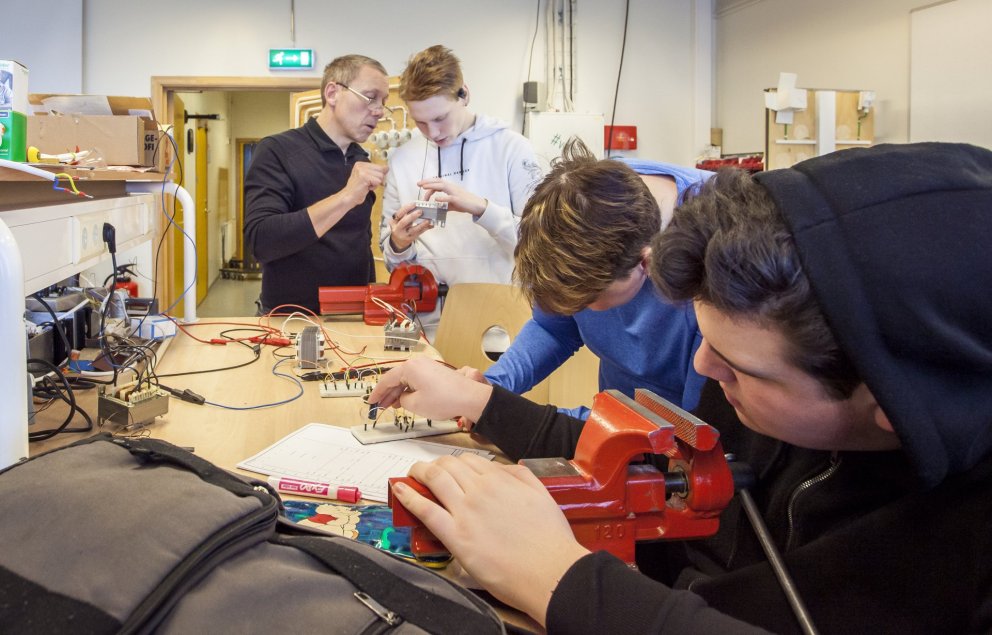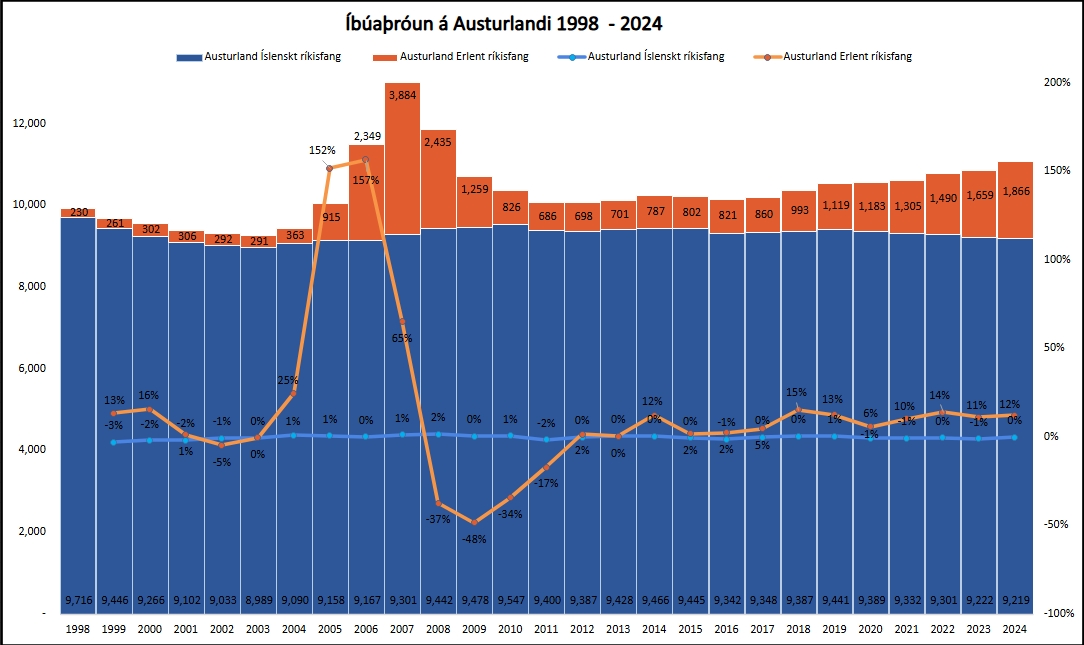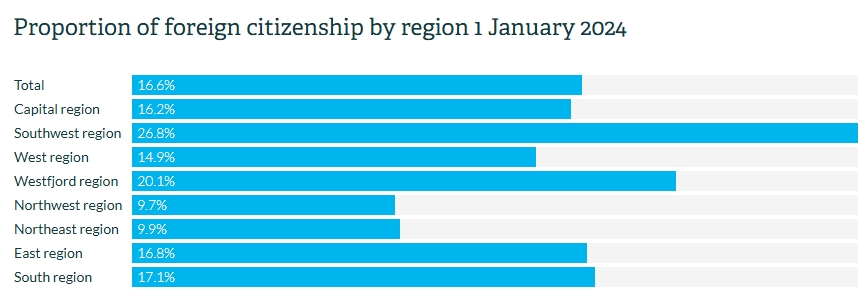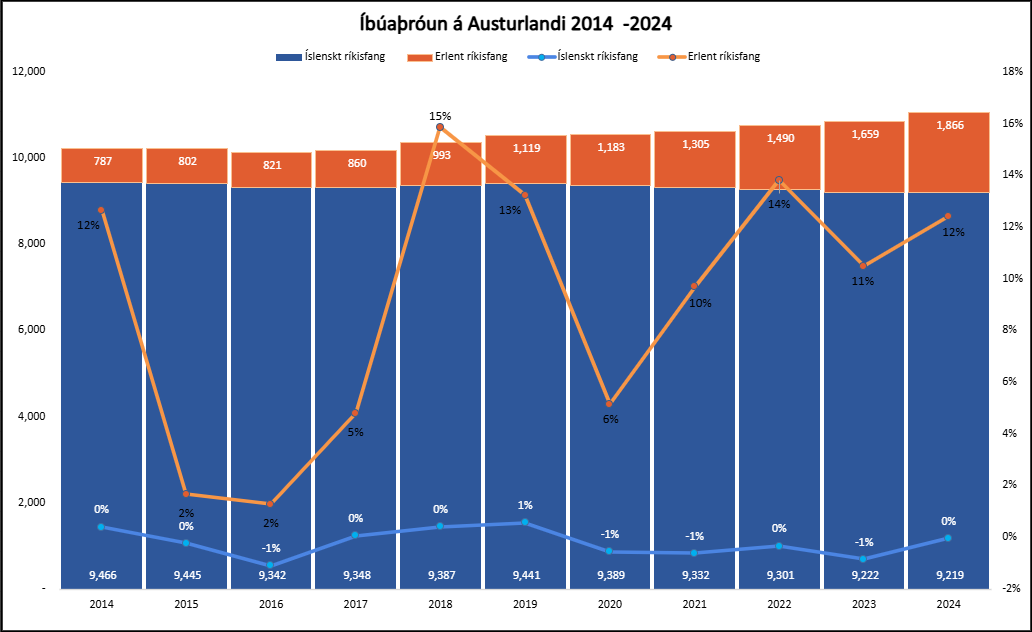Immigrants and the Community – teamwork that matters

Over the past two decades, the population of East Iceland has undergone notable changes, with the most prominent trend being the growing diversity of its residents. The proportion of immigrants has multiplied since the turn of the century, and in 2024, one in every six residents in East Iceland is of foreign origin.
This development reflects broader national trends. Immigrants are settling across Iceland and playing an increasingly important role in society. In East Iceland, this has been especially significant as many towns face population decline and an aging population.
In 2003, foreign nationals made up about 4% of East Iceland’s population. By 2024, that share had risen to nearly 17%. This means that close to one in six residents is now of foreign origin, while the number of native residents in the area has remained stable or even declined slightly in recent years. This trend highlights how important immigrants are in maintaining population numbers and counteracting rural depopulation.
This increase is partly related to large-scale industrial development in the region. However, it's important to note that foreign born residents work not only at the aluminium factory but also in fisheries, tourism, and a range of service and care-related roles.
Immigrants in East Iceland are especially prominent in fisheries and heavy industry: 30% of employees at Alcoa Fjarðaál are of foreign origin, 26% at Síldarvinnslan, and 48% at the Loðnuvinnslan fish processing plant.
"The team working here at Fjarðaál is truly diverse, and that’s part of what makes the workplace so vibrant. There is a great deal of human capital in this group, and we are proud that people come from all over to work for Fjarðaál. Higher wages in the aluminum plant likely contribute to its appeal. Diversity is reflected throughout the company, where we have employees of foreign origin in a wide range of roles and managerial positions."
- Vigdís Diljá, Manager of corporate affairs, Alcoa Fjarðaál
Education as an underused Asset
The latest data from Statistics Iceland shows that a large portion of immigrants in East Iceland hold university degrees. About 25% have a bachelor's degree or higher, compared to around 15% among native residents. Immigrants also appear more likely to hold vocational or technical qualifications. This indicates that many immigrants bring valuable knowledge, experience, and education that can benefit the community. However, many are working in jobs where their qualifications are underutilized. This represents a clear opportunity to make better use of the human resources already present in our society. Further coverage of education in East Iceland will be published soon based on data from the sustainability project at sjalfbaerni.is.
|
|
Fjarðabyggð |
Múlaþing |
Vopnafjörður |
Fljótsdalur |
Austurland |
|---|---|---|---|---|---|
|
Total population |
5.163 |
5.177 |
650 |
95 |
11.085 |
|
Native Icelandic residents |
4.154 |
4.406 |
581 |
78 |
9.219 |
|
Foreign nationals |
1.009 |
771 |
69 |
17 |
1.866 |
|
% Foreign nationals |
20% |
15% |
11% |
18% |
17% |
|
Number of nationalities |
45 |
51 |
17 |
10 |
66 |
|
Most common nationality |
Poland 595 |
Poland 220 |
Poland 27 |
* |
Poland 842 |
|
Second most common |
Romania 115 |
Ukraine 42 |
Bulgaria 11 |
* |
Romania 153 |
Language is the key to belonging
Supporting immigrants' participation in society requires providing realistic opportunities for integration – and language skills play a key role. Austurbrú organizes Icelandic as a Second Language courses, which about 280 individuals attend each year. Still, this number does not reflect the total foreign population here, as over 1,850 foreigners live in the region.
Síldarvinnslan has entered into a two-year agreement with Austurbrú to provide Icelandic lessons during working hours, with staff receiving remote lessons two to three times per week. This follows in the footsteps of Búlandstindur (now Kaldvík) in Djúpivogur, which previously offered on-site Icelandic lessons during work hours. Alcoa Fjarðaál has also taken an innovative approach, offering all employees access to the language app "Bara tala" to learn Icelandic, either independently or with a tutor. The initiative has been very well received by foreign staff, and the majority have enrolled in the program.
This presents an opportunity for the business sector to step up, take the initiative, and offer practical solutions that support language learning and integration for their international employees.
|
Country of origin |
Total |
|---|---|
|
Poland |
842 |
|
Romania |
153 |
|
Lituania |
97 |
|
Ukraine |
73 |
|
Spain |
53 |
|
Germany |
50 |
|
Latvia |
47 |
|
Czech Republic |
47 |
|
Denmark |
41 |
|
Hungary |
35 |
|
Philippines |
33 |
Reynslan af fyrstu hendi
arbara Izabela Kubielas, who lives in Fjarðabyggð, describes Icelandic society as generally welcoming towards immigrants. She notes that English is widely spoken and that many resources are accessible in Polish. Having lived in Iceland since 2008, she says it is easy to meet fellow Polish people in everyday settings such as shops, schools, and workplaces. She emphasizes the importance of access to Icelandic language education and mentions positive experiences where Polish teachers have even led Icelandic language courses.
In her experience, the lifestyle in East Iceland is calmer and more straightforward than in the capital, and adaptation can happen quickly for those who choose to settle down there. She describes the Polish community in Fjarðabyggð as active - they engage in cultural events and enjoy their daily life, often through their children - who learn both Polish and Icelandic at school. Events like the Polish film day in Eskifjörður and community meetings in cooperation with local authorities have helped strengthen connections. While some still hesitate to participate, for example due to language or cultural barriers, she observes that the Polish community is becoming more confident and active with each passing year. The growth of the immigrant population has been essential in maintaining basic services and keeping the local economy running, while also bringing new culture, perspectives, and experiences that enrich the community and strengthen ties to the wider world. Although the trend is largely positive, challenges remain. Issues like housing, language skills, and access to information can affect how well newcomers adapt and find their place. That’s why collaboration between municipalities, institutions, and employers is key to creating an environment that supports participation by all.
Immigrants and population trends in East Iceland over the past two decades clearly show that immigrants are playing an increasingly important role. While the number of native residents has remained unchanged or declined, the proportion of foreign nationals has risen steadily. Since 2003, the number of immigrants has increased more than sixfold, and they now make up nearly 17% of the region’s population. This growth has helped reverse population decline, sustained the labor market, and brought new culture, knowledge, and vitality that strengthen society as a whole.
Interestingly, this growth has occurred without a significant increase in the number of native residents, indicating that population growth in East Iceland in recent years has been driven almost entirely by immigration.
How We Come Together – and Become a Community
Austurbrú’s project "This is Our Community" recently received a grant from the Development Fund for Immigrant Issues. The project aims to promote inclusion of immigrants in East Iceland by improving access to information, empowering participation in civic life, and creating space for dialogue and cooperation between different groups.
In addition, six women graduated last year from Austurbrú’s community interpreter program, which equips participants with the skills to provide professional interpretation and supports inclusion in diverse settings. The course lasted three months and included participants from Poland and Ukraine. Projects like this show that inclusion is not only about formal education, but also about social connections and shared experiences.
One such shared experience is the event Connected by Food, held for the first time in 2024 and again in May 2025. People of diverse backgrounds gathered to share dishes from their home countries. This year featured food from 17 nations and drew a large crowd to enjoy, taste, and connect – a vibrant and effective way to bring people together through food. The event was supported by Múlaþing and the East Iceland Regional Development Plan.

Graph: Changing community composition over the past 20 years, the proportion of immigrants in East Iceland has steadily increased, reshaping the region’s social fabric. Immigrants have become the main driving force behind population growth and are a key part of the region’s future development.
The trend we are witnessing is not just data on a graph – it is a reminder that immigrants play a vital role in the future of East Iceland. A diverse society does not create itself; it needs nurturing. But when immigrants are given real opportunities to participate, we all become stronger together.
This is the fourth and final article in a series on population development in East Iceland. Upcoming topics include gender equality in the labor market, income statistics for East Icelanders, and education.
Author: Lilja Sif Magnúsdóttir
liljasif@austurbru.is





